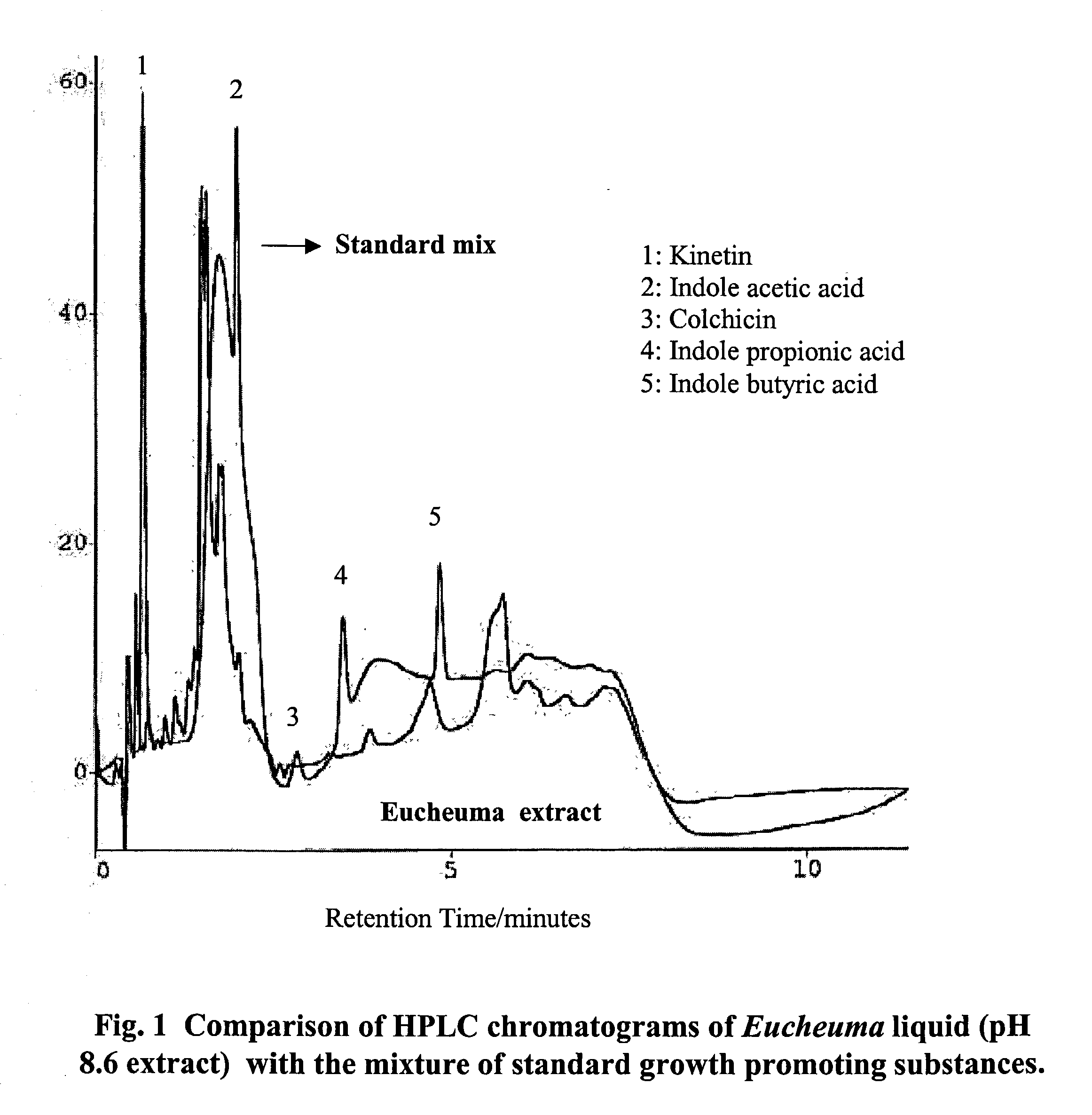Integrated method for production of carrageenan and liquid fertiliser from fresh seaweeds
a technology of carrageenan and liquid fertiliser, which is applied in the direction of liquid fertilisers, biocide, applications, etc., can solve the problems of not reporting the preparation of any fertilizer from the same seaweed, and the conditions under which seaweeds are normally processed for phycocolloid extraction can be detrimental, so as to achieve superior raw materials for recovery
- Summary
- Abstract
- Description
- Claims
- Application Information
AI Technical Summary
Benefits of technology
Problems solved by technology
Method used
Image
Examples
example 2
[0042] 10 g of the 45-day old dried whole plant of Example 1 was treated with 8% aqueous KOH at 75-80.degree. C. for 3 h to prepare semi-refined carrageenan (SRC). The yield of product after work-up was 43.2% and its gel strength measured under standard conditions was 400 g / cm.sup.2. 10 g of the solid powder residue of Example 1 was similarly processed for SRC. The corresponding values of yield and gel strength were 60.0% and 370 g / cm.sup.2. Yields were expressed with respect to bone dry raw material.
example 3
[0043] 20 kg lots of freshly harvested 90-day old seaweed were processed as per the procedure of Example 1 to yield 2.31 kg of dry whole plant in one case, and 1.32 kg of dry solid residue powder and 13.3 kg of sap in the second case. 10 g each of dry whole plant and solid residue powder were processed further for extraction of SRC as per the procedure of Example 2 and the yields obtained were 42.9% and 57.5%, respectively. The corresponding gel strengths were 360 g / cm.sup.2 and 390 g / cm.sup.2, respectively.
[0044] For Kappaphycus alvarezii cultivated in the Diu coast, India, 2% washed residue gave a gel strength of 520 g / cm.sup.2 whereas 1% gel obtained with SRC prepared from the residue had a gel strength of 515 g / cm.sup.2. This suggests that it may be possible to use washed residue directly for certain applications although its usage level relative to SRC may be higher.
example 4
[0045] 10 g each of 45-day old dry whole plant and solid residue powder of Example 1 were processed separately for extraction of refined carrageenan. The method involved adding 300 mL saturated aqueous Ca(OH).sub.2 solution and cooking in an autoclave at 107.degree. C. and 12 psi pressure for 1 h. The product was precipitated with isopropyl alcohol, filtered and dried. The yields of refined carrageenan from whole plant and residue powder were 28.3% and 47.6%, respectively while the corresponding gel strengths were 600 g / cm.sup.2 and 595 g / cm.sup.2, respectively. Accounting for moisture content in the dry whole plant and solid residue powder, the yields of .kappa.-carrageenan w.r.t fresh seaweed are approximately comparable, indicating that no .kappa.-carrageenan is lost in the sap.
PUM
| Property | Measurement | Unit |
|---|---|---|
| Fraction | aaaaa | aaaaa |
| Fraction | aaaaa | aaaaa |
| Fraction | aaaaa | aaaaa |
Abstract
Description
Claims
Application Information
 Login to View More
Login to View More - R&D
- Intellectual Property
- Life Sciences
- Materials
- Tech Scout
- Unparalleled Data Quality
- Higher Quality Content
- 60% Fewer Hallucinations
Browse by: Latest US Patents, China's latest patents, Technical Efficacy Thesaurus, Application Domain, Technology Topic, Popular Technical Reports.
© 2025 PatSnap. All rights reserved.Legal|Privacy policy|Modern Slavery Act Transparency Statement|Sitemap|About US| Contact US: help@patsnap.com

